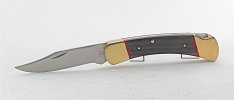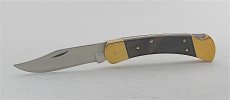Over the years, I have given a lot of thought to handle pin placement on the Two Dot knives and why the rear pin placement changed.
There are three important things to remember if you want to follow my idea.
FIRST, the Two Dot knives were Buck’s start with sintered frames, which were much wider top to bottom than the forged frames of the earlier knives—the wood was wider.
SECOND, the bolster has a slant where it meets the wood—it is not straight up and down and it slants away from the wood scale at the bolsters.
THIRD, wood shrinks and swells according to changes in relative humidity; however, it does not shrink and swell equally in all directions. There is virtually no shrinking or swelling along the length of a piece of wood, but there can be significant changes in width across the grain of the wood. Remember that these scales were solid wood, not laminates like Dymondwood. One additional thing to remember is that when Buck started using the sintered frames, they quit using adhesive to hold the scales to the frame. Pins were the sole attachment.
I have been told that not long after the first Two Dot knives were sold Buck got some complaints that the fit of the wood was not good—there were slight gaps between the wood and the bolsters, especially at the rear bolster. If you have ever done some fine wood working you know that even a slight gap can look like the Grand Canyon. One explanation would be that the wood had not been cut correctly, but I think that is doubtful. A more likely explanation is that the knife ended up in an environment with a much higher relative humidity than the environment of the Buck plant in San Diego and the wood swelled. That environment could be a different part of the country or it could be that the knife was kept in a closed container such as a tool box, which could be like putting it in a humidity chamber. In addition to the slight gap there were some comments that the wood was lifting away from the frame because of warping.
What follows may be clear as mud, but I hope I get my idea across. With an increase in relative humidity of the environment, wood takes in moisture and swells. With a decrease in relative humidity, wood loses moisture and shrinks. Those changes occur in the width and thickness of the wood. The length of the wood does not change, and that brings up the question of how a slight gap could form with swelling of the wood if the length of the wood doesn’t change. Take a look at the first photo, which is a first variation of the Two Dot knife. The red arrows show the direction of wood movement as swelling occurs. For the rear bolster movement will be towards the bottom of the knife. The slant of the metal bolster causes mechanical resistance to movement towards the top. The size of the arrows is an exaggeration, but they illustrate the idea. If the tail end of the arrow is the original location for the end of the wood, the tip of the arrow is the location of that point after swelling occurs. The tip is farther away from the bolster even though the length of the wood has not changed, and a gap will occur.
The black lines in the photo illustrate a second fact. Gain, or loss, of moisture through end grain of wood occurs at a rate about 16 times greater than through the top/bottom and side surfaces of a piece of wood. That means that the ends of a piece of wood shrink and swell much more quickly than areas away from the ends. If you have ever bought lumber, you may have noticed that the ends of a piece show checks or cracks. That is because of greater swelling and shrinking at the ends of the wood. Because the wood slab of the knife is cut as a curve, the black lines show areas where end grain is exposed, not only at the end of the slab, but also along the curve. Gain or loss of moisture is greater in those areas.
The second photo is the final variation of the Two Dot knives. Notice the two rear handle pins. They are located closer to the bolster and to the edges of the wood. Those pins create more resistance to wood movement as a result of shrinking and swelling. I don’t know the actual reason Buck used those pins, but they do lessen the chance of a gap forming between the bolster and the wood.





